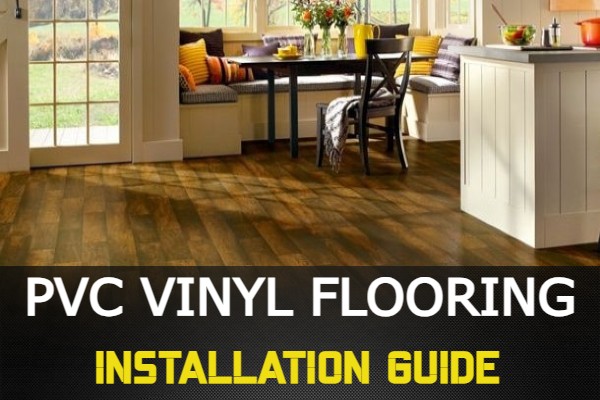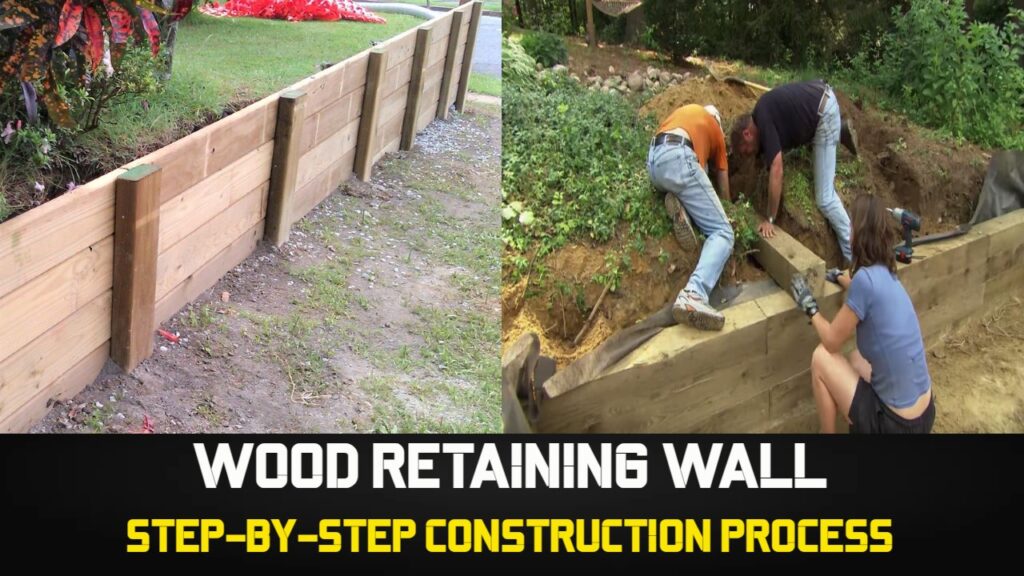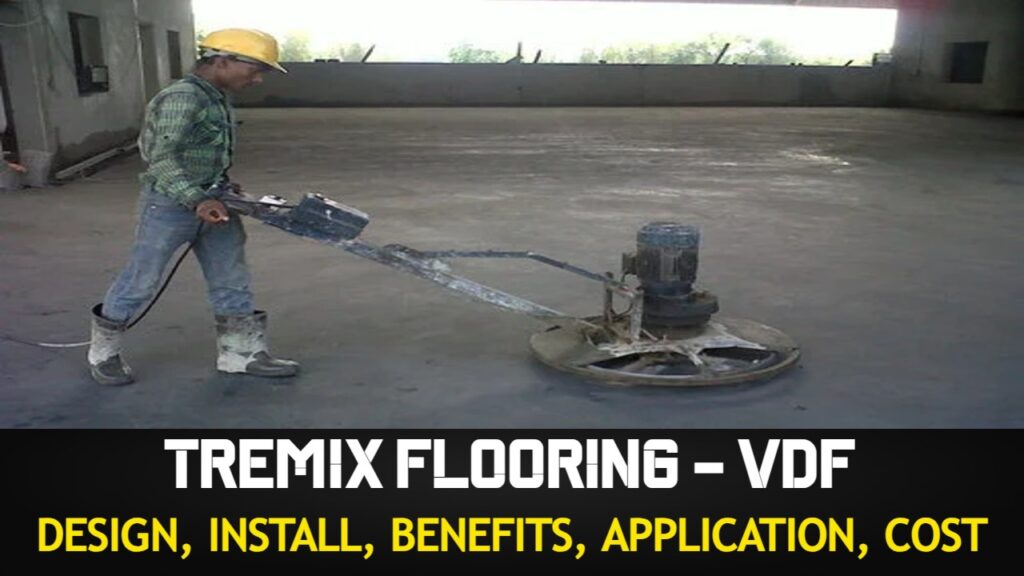PVC flooring, often known as vinyl flooring, has been extremely popular in recent years because of its low cost, toughness, and adaptability. Understanding the important features of vinyl flooring is crucial for making an informed choice, whether you’re remodeling your house or preparing to install new flooring. This post will go over 15 key points you need to be aware of before installing vinyl flooring.
Contents
- 1 Introduction
- 2 Types of Vinyl Flooring
- 3 Advantages of Vinyl Flooring
- 4 Disadvantages of Vinyl Flooring
- 5 Installing PVC Vinyl Flooring
- 6 Cleaning and Maintenance
- 7 Conclusion
- 8 Frequently Asked Questions (FAQs)
- 8.1 Can vinyl flooring or PVC flooring be installed over existing flooring?
- 8.2 Can PVC flooring be installed in bathrooms and kitchens?
- 8.3 Is PVC flooring suitable for pets?
- 8.4 Can PVC flooring be repaired if damaged?
- 8.5 How long does PVC flooring typically last?
- 8.6 Can PVC flooring be installed in basements?
- 8.7 Is underlayment necessary for PVC flooring?
- 8.8 Can PVC flooring be installed on the stairs?
- 8.9 Does PVC flooring fade in sunlight?
- 8.10 Can PVC flooring be installed in areas with radiant heating?
Introduction
A synthetic flooring material called vinyl may mimic the appearance of real materials like wood, stone, or tile. It has a wear layer, a printed design layer, and a backing layer, among other layers. Together, these layers provide a flooring option that is both durable and beautiful. Knowledge about Vinyl Flooring
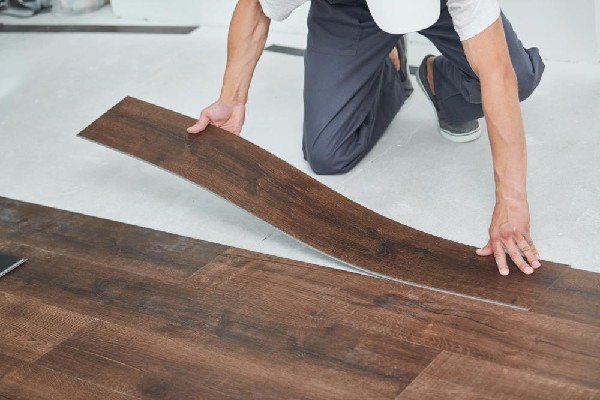
Vinyl flooring is available in a variety of styles, including sheet vinyl, luxury vinyl tile, and luxury vinyl plank. LVT and LVP are made to seem like hardwood or tile, whereas sheet vinyl has a more smooth, continuous appearance. Each variety has distinct qualities and advantages of its own.
Types of Vinyl Flooring
Luxury Vinyl Plank (LVP)
For homeowners desiring the appearance of hardwood flooring without exorbitant expenses and upkeep, LVP is a popular option. It has a genuine wood-like look and is offered in a variety of sizes and finishes. Individual planks of LVP are often laid, making it simple to repair them if they become damaged.
Luxury Vinyl Tile (LVT)
LVT costs a fraction of what genuine stone or ceramic tiles do yet delivers a similar aesthetic. It is offered in many forms, sizes, and patterns, opening up a world of creative options for patterns and arrangements. LVT is an excellent alternative for damp spaces like bathrooms or kitchens.
Sheet Vinyl
The seamless and waterproof solution is provided by sheet vinyl, which is a continuous roll of flooring material. It is a cost-effective option for broad regions and quite simple to install. There are many different patterns for sheet vinyl, including ones that imitate wood, stone, or tile.
Advantages of Vinyl Flooring
Durability and Longevity
The longevity of vinyl flooring is one of its main benefits. It is appropriate for high-traffic areas since it is scratch, stain, and dent resistant. Furthermore, vinyl flooring is renowned for its durability; with the right upkeep, it may last for many years.
Water Resistance
Vinyl flooring is a viable option for places exposed to wetness because of its strong water resistance. Compared to hardwood or laminate flooring, it is less prone to water damage. It’s crucial to remember, though, that sufficient moisture might still leak through the seams and result in problems.
Easy Maintenance
Low upkeep is required for vinyl flooring. It can often be kept clean with routine sweeping or vacuuming and occasional mopping. Vinyl flooring doesn’t require refinishing or intensive maintenance as hardwood or carpet do.
Affordability
Comparing vinyl flooring to other flooring options, it is a more affordable alternative. At a far lower price, it provides a similar aesthetic appeal to natural materials. For homes on a tight budget, vinyl flooring is a desirable option because of its affordability.
Also Read: Understanding Magnesite Bricks: Types, Composition, Construction Applications, Pros, Cons
Disadvantages of Vinyl Flooring
Susceptible to Scratches and Dents
Although vinyl flooring is resilient, it is not completely impervious to dents and scratches. There is a chance that the surface will be scratched by sharp items or heavy furniture. Utilizing area rugs and furniture padding, as well as avoiding pulling heavy objects, can all assist to alleviate this problem.
Limited Design Options
Despite having a large variety of styles, vinyl flooring may have limits when compared to natural materials. Compared to actual wood or stone, the patterns and textures might not be as realistic. However, improvements in printing technology have greatly enhanced vinyl flooring’s aesthetic appeal.
Environmental Concerns
Because vinyl flooring is comprised of synthetic materials, some people are concerned about the environment. PVC, a kind of plastic that can emit volatile organic compounds (VOCs), is used in the production process. But many producers now provide low-VOC or phthalate-free alternatives.
Installing PVC Vinyl Flooring
To guarantee a successful and durable installation of vinyl flooring, appropriate preparation is essential before beginning.
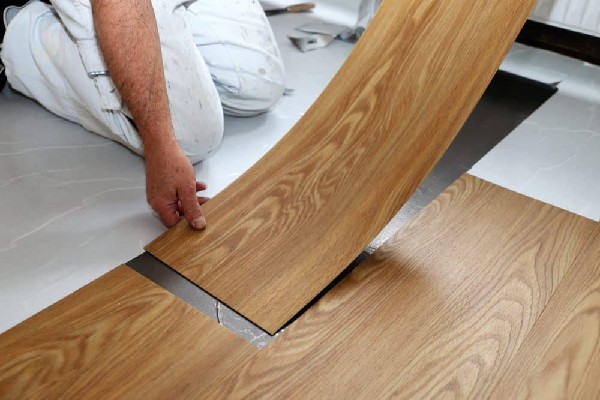
Preparing the Subfloor
Before beginning the PVC vinyl flooring installation, the subfloor must be properly prepared. To guarantee a successful installation, follow these steps:
- Remove existing flooring: Remove any carpet, tiles, or other floor coverings from the space. Make sure the surface is well-cleansed and debris-free.
- Inspect for imperfections: Check the subfloor closely for any cracks, lumps, or unevenness. To provide a flat and secure base for the vinyl flooring, fix any problems by fixing gaps and leveling uneven spots.
- Moisture testing: To find out if the subfloor has an excessive amount of moisture, perform a moisture test. This action is crucial for avoiding future issues like warping or the formation of mould. To conduct a precise moisture test, refer to the manufacturer’s instructions or seek expert advice.
Gathering the Necessary Tools and Materials
A good PVC vinyl flooring installation requires the following equipment and supplies, which should be gathered in advance:
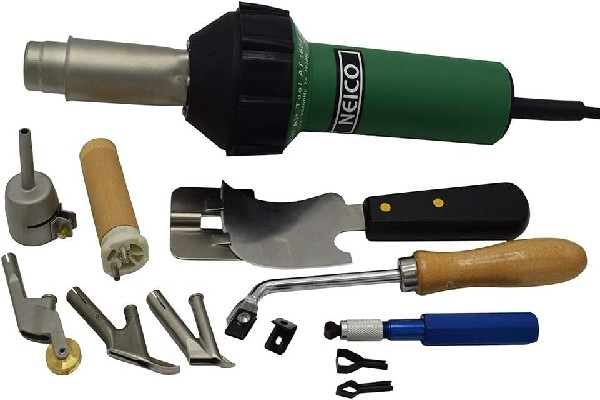
- PVC vinyl flooring planks or tiles
- Utility knife
- Measuring tape
- Chalk line
- Straightedge
- Adhesive (compatible with PVC vinyl flooring)
- Notched trowel
- Roller (for pressing down the flooring)
- Transition strips (if required)
- Safety goggles and knee pads (for personal protection)
Acclimating the Vinyl Flooring
The PVC vinyl flooring needs time to adjust to the humidity and temperature of the space in order to work at its best. Take these actions:
- Unbox the flooring: Place the vinyl flooring in the room where the installation will take place after removing it from its packing. Give it at least 24 hours to acclimatize so that it can acclimatize to the surrounding environment.
- Maintain optimal conditions: During the acclimatization phase, make sure the room’s temperature and humidity levels stay within the manufacturer’s suggested range. This process stops the vinyl flooring from expanding or contracting too much after installation.
Installing PVC Vinyl Flooring
It’s time to start installing the PVC vinyl flooring now that the subfloor has been prepped and you have acquired the required equipment and materials. To ensure a successful installation, follow these steps:
- Plan the layout: Planning the flooring arrangement first while keeping the room’s size and form in mind is a good place to start. To guarantee straight and even installation, precisely measure the space and outline the perimeter with a chalk line.
- Cutting the flooring: Cut the vinyl flooring planks or tiles to fit around entrances, corners, or uneven places using a utility knife and straightedge. For a smooth look, take exact proportions.
- Apply adhesive: Apply the proper glue to the subfloor using a notched trowel as directed by the manufacturer. To encourage effective bonding between the subfloor and vinyl flooring, make sure the covering is equal.
- Install vinyl flooring: Lay the vinyl flooring planks or tiles out according to the arrangement you had in mind. To achieve a solid binding between each piece and the glue, apply hard pressure.
- Finishing touches: When the floor is all coated, push the vinyl flooring down with a roller to create a flat, even surface. For a neat and finished appearance, trim off any extra material at the edges.
- Enjoy your new flooring: Congratulations! Your PVC flooring installation was successful. Enjoy the beauty and durability that PVC flooring gives as you take time to admire the change of your room.
You may get exceptional results and outperform other websites in terms of educational and high-quality information linked to installing PVC flooring according to our thorough installation instructions.
Cleaning and Maintenance
The lifespan and aesthetic appeal of your vinyl flooring may be increased with proper cleaning and upkeep.
Regular Cleaning Routine
To regularly get rid of dirt and debris, sweep or hoover the floor. For more thorough cleaning, use a moist mop and a mild vinyl floor cleanser. Avoid using strong chemicals or abrasive instruments that might scratch the surface.
Avoiding Harsh Chemicals
Certain cleaning solutions can harm or discolor vinyl flooring. Avoid using ammonia- or wax-based products, as well as abrasive cleansers. Choose pH-neutral cleansers designed especially for vinyl flooring instead.
Dealing with Stains and Spills
Clean up spills and stains right away using a moist cloth or sponge. Liquids shouldn’t be left on the floor for a long time since they can harm the seams by seeping in. Consult the manufacturer’s instructions for particular stain removal methods for difficult stains.
Conclusion
For homeowners, installing PVC flooring may be a sensible and affordable decision. Making an informed choice requires knowledge of the many PVC flooring options, their benefits, and any potential pitfalls. To ensure the durability and attractiveness of your PVC flooring, proper preparation, installation, and maintenance are essential.
Vinyl flooring is a durable, water-resistant, and low-maintenance solution for a variety of rooms in your house. It also has a beautiful appearance. You may confidently move on with your PVC flooring installation project by taking into account the criteria highlighted in this article.
Frequently Asked Questions (FAQs)
Can vinyl flooring or PVC flooring be installed over existing flooring?
Yes, The majority of the time, flooring made of PVC may be put over flooring made of tile, hardwood, or concrete. However, it’s crucial to check that the current flooring is in good shape and is ready for installation.
Can PVC flooring be installed in bathrooms and kitchens?
Yes, Because it resists water, PVC flooring is a great option for bathrooms and kitchens. To stop water seepage, good installation, and seam sealing are essential.
Is PVC flooring suitable for pets?
PVC flooring is pet-friendly as it is resistant to scratches and stains. However, large dogs with sharp nails may still cause some damage over time.
Can PVC flooring be repaired if damaged?
Yes, PVC flooring can be repaired. Damaged planks or tiles can be replaced individually without the need to remove the entire floor.
How long does PVC flooring typically last?
PVC flooring’s lifespan is influenced by a number of variables, including its quality, upkeep, and foot activity. Vinyl flooring may often last 10 to 20 years or longer with proper maintenance.
Can PVC flooring be installed in basements?
Yes, PVC flooring is suitable for basements as it is moisture-resistant. However, it is crucial to address any moisture issues in the basement before installation.
Is underlayment necessary for PVC flooring?
For PVC flooring, underlayment is typically not necessary. Underlayment can be employed, nevertheless, in circumstances when more cushioning or sound absorption is necessary.
Can PVC flooring be installed on the stairs?
Yes, PVC flooring can be installed on stairs. There are specific vinyl stair treads available for this purpose.
Does PVC flooring fade in sunlight?
Although PVC flooring is fade-resistant, extended exposure to direct sunlight can eventually cause some fading. This problem can be lessened by using UV-protective coatings or window coverings.
Can PVC flooring be installed in areas with radiant heating?
Yes, Radiant heating systems are compatible with PVC flooring. However, it’s crucial to adhere to the installation procedures and temperature restrictions specified by the manufacturer.
